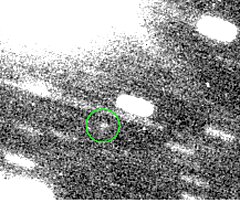Ferdynand (księżyc)
| ||
 | ||
| Planeta | Uran | |
| Odkrywca | Matthew Holman, John Kavelaars, Dan Milisavljevic, Brett Gladman | |
| Data odkrycia | 13 sierpnia 2001 | |
| Tymczasowe oznaczenie | S/2001 U2 | |
| Charakterystyka orbity | ||
| Półoś wielka | 20 430 000 km[1] | |
| Mimośród | 0,3993[1] | |
| Okres obiegu | 2 790,03 d[1] | |
| Nachylenie do ekliptyki | 169,793°[1] | |
| Długość węzła wstępującego | 217,350°[1] | |
| Argument perycentrum | 156,298°[1] | |
| Anomalia średnia | 26,163°[1] | |
| Własności fizyczne | ||
| Średnica równikowa | ~20 km | |
| Średnia gęstość | 1,3 g/cm³ | |
| Albedo | 0,04 | |
| Jasność obserwowana (z Ziemi) | 25,1m | |
Ferdynand (Uran XXIV) – najbardziej zewnętrzny znany księżyc Urana. Jest to niewielki (średnica około 20 km), ciemny księżyc, który okrąża macierzystą planetę ruchem wstecznym[2]. Nazwany został imieniem syna króla Neapolu z Burzy Williama Szekspira[2].
Został odkryty przez Matthew Holmana, Johna Kavelaarsa, Dana Milisavljevica i Bretta Gladmana 13 sierpnia 2001 roku w Międzyamerykańskim Obserwatorium Cerro Tololo. Mimo że został zaobserwowany ponownie 21 września i 15 listopada, a także rok później, 13 sierpnia i 5 września 2002 r., to potem ślad po nim zaginął. Ostateczne potwierdzenie odkrycia nastąpiło 24 września 2003 r., kiedy Scott Sheppard uchwycił księżyc na zdjęciach zrobionych przez Davida Jewitta i siebie 29-30 sierpnia i 20 września. Obserwacja została też potwierdzona 30 września przez Holmana[3].
Zobacz też
Przypisy
- ↑ a b c d e f g Planetary Satellite Mean Orbital Parameters (ang.). Jet Propulsion Laboratory, 2011-12-14. [dostęp 2012-10-28].
- ↑ a b Ferdinand (ang.). W: Solar System Exploration [on-line]. NASA. [dostęp 2018-12-25].
- ↑ Daniel W. E. Green: International Astronomical Union Circular 8213: S/2001 U 2, S/2002 N 4; C/2003 S4 (ang.). IAU Central Bureau for Astronomical Telegrams, 2003-10-01. [dostęp 2014-09-07]. [zarchiwizowane z tego adresu (2013-10-06)].
Media użyte na tej stronie
This is a revised version of Solar_System_XXIX.png.
This image of Uranus was compiled from images returned Jan. 17, 1986, by the narrow-angle camera of Voyager 2. The spacecraft was 9.1 million kilometers (5.7 million miles) from the planet, several days from closest approach. This picture has been processed to show Uranus as human eyes would see it from the vantage point of the spacecraft. The picture is a composite of images taken through blue, green and orange filters. The darker shadings at the upper right of the disk correspond to the day-night boundary on the planet. Beyond this boundary lies the hidden northern hemisphere of Uranus, which currently remains in total darkness as the planet rotates. The blue-green color results from the absorption of red light by methane gas in Uranus' deep, cold and remarkably clear atmosphere.
Three images showing the Uranian satellite S/2001 U2 (Ferdinand). The full CTIO observation set are sub-divided into three batches that were shifted at the rate and direction of the motion of Uranus and then recombined. The satellite is indicated by the circle in each image and can be seen moving from left to right. The elongated features in the images are stars that have been smeared out by the shifting process.



